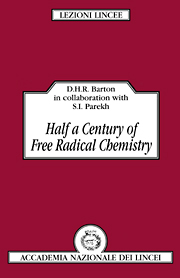Book contents
- Frontmatter
- Contents
- Preface
- 1 The pyrolysis of chlorinated hydrocarbons
- 2 Phenolate radical coupling in synthesis and biosynthesis; Pummerer's ketone
- 3 Nitrite photolysis (the Barton reaction)
- 4 Radical deoxygenation (the reaction of Barton and McCombie)
- 5 Disciplined radicals and disciplinary radical reactions (Barton decarboxylation)
- 6 Some recent synthetic applications of Barton radical methodologies
- Author index
- Subject index
6 - Some recent synthetic applications of Barton radical methodologies
Published online by Cambridge University Press: 11 October 2009
- Frontmatter
- Contents
- Preface
- 1 The pyrolysis of chlorinated hydrocarbons
- 2 Phenolate radical coupling in synthesis and biosynthesis; Pummerer's ketone
- 3 Nitrite photolysis (the Barton reaction)
- 4 Radical deoxygenation (the reaction of Barton and McCombie)
- 5 Disciplined radicals and disciplinary radical reactions (Barton decarboxylation)
- 6 Some recent synthetic applications of Barton radical methodologies
- Author index
- Subject index
Summary
Free radical reactions have had a rather rapid and yet far-reaching impact on synthetic planning in organic synthesis in recent years. This is due to the realization of certain obvious advantages that radical methods enjoy over classical ionic reactions. Tandem radical cyclization for the construction of polycyclic ring systems and a large number of applications of this powerful strategy that can be found in the literature illustrates the above point quite adequately. The foundation of such strategic synthetic planning relies heavily on the synthetic tools and the relevant mechanistic understanding available at one's disposal. The chemistry discussed in the last two chapters has dealt with the various radical reactions associated with the thiocarbonyl group. Their invention, the following successful development of various synthetic applications, and the resulting mechanistic understanding of these reactions have undoubtedly made it a very important part of the organic synthetic tools in general. Though this is still a developing field, recently there has been an increasing number of reports on synthetic applications, adaptations or modifications of Barton radical methodologies, which justifies a summary of the same. There are, of course, several excellent treatises available in the literature, where a detailed picture of the reactivity, selectivity, and stability of many types of organic radicals are portrayed. For synthetic utility radical chain reactions are essential, and recently, Giese has provided excellent treatments of various radical methodologies both from a theoretical and synthetic standpoint. With respect to the present discussion, Ramaiah, Curran, Hart, and Crich (to varied lengths) have discussed several examples which portray the multitude of functional groups and skeletal types which can be easily accommodated by the Barton radical methodologies.
- Type
- Chapter
- Information
- Half a Century of Free Radical Chemistry , pp. 91 - 147Publisher: Cambridge University PressPrint publication year: 1993



